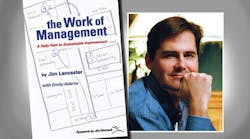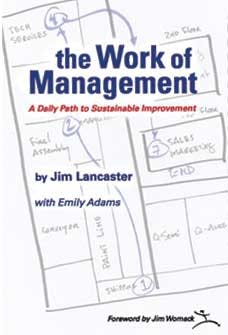It is easy to think of lean manufacturing as a linear process. You install a lean system, you train your people, you hold kaizens and make improvements and the factory gets better every day. You're on a lean journey, a forward step at a time. It's hard work, no doubt, but that steady progress pays off.
That seemed to be the story at Lantech, the Louisville, Ky., manufacturer of stretch wrap machinery and one of the most heralded examples of the power of lean manufacturing. Lantech founder Pat Lancaster began using lean methods in his company in 1994. Over the next few years, the company greatly improved its processes and its finances. Lantech was featured in Lean Thinking, the influential 2003 book on lean by James P. Womack and Daniel T. Jones.
Lantech has grown steadily since instituting the daily management system in 2009 and has seen its profits regularly improve by double digits.
But by the early 2000s, CEO Jim Lancaster reveals in his new book The Work of Management, Lantech "was not delivering great business results" despite myriad kaizen projects. "Every week, teams reported savings of time and money, but it all seemed to evaporate before it could hit the income statement," he writes. Kaizen teams improved one area of the plant while problems returned in another department.
"Parts supply and quality are unstable. Employees and customers can be unsteady. Tools are unreliable," Lancaster writes. "We spend a lot of time trying to organize the elements just enough every day so that products get shipped, people stay safe and money gets made."
Morgan's insight was to establish standard work and then have the management team focus its efforts on helping production workers maintain that work. That meant taking corrective action as soon as possible when problems were small.
The daily management system that Lantech instituted involves a degree of standard work for every manager and executive, including Lancaster. A cascading series of meetings are held each morning so that any problems in the work cells and supporting departments are communicated to the levels of the company that need to provide decisions or assistance. Visual boards are used to track key operating metrics and make them easily visible.
Lancaster writes that Morgan had insisted that the company calculate "run rates" – the performance of a process over a 90-day period – and track them instead of a quality goal or target. "He said improvement happens only when we are looking closely at what is instead of what we hope for," Lancaster notes.
For Lancaster, one of the key learnings was not to be the man with the answers to every problem. After working in nearly every department in the company since he was young, he thought he had a solution to any quandary that popped up. But he came to realize that his function instead was to ensure that managers and employees were using lean techniques to identify and solve problems. It also meant understanding that problems were an opportunity to improve the operations and products.
Rooting out problems early and maintaining stable operations, Lancaster emphasizes, is not a formula for simply treading water. Lantech has grown steadily since instituting the daily management system in 2009 and has seen its profits regularly improve by double digits. He says having that system has unlocked "massive" value because efforts are not wasted on pursuing the same problems without solving the underlying causes. It is a system that recognizes the "strange and bad" issues and then fixes them quickly and efficiently.






